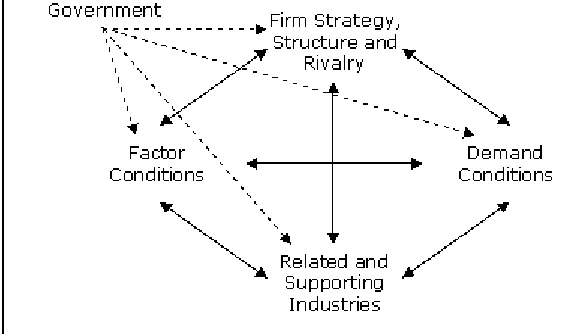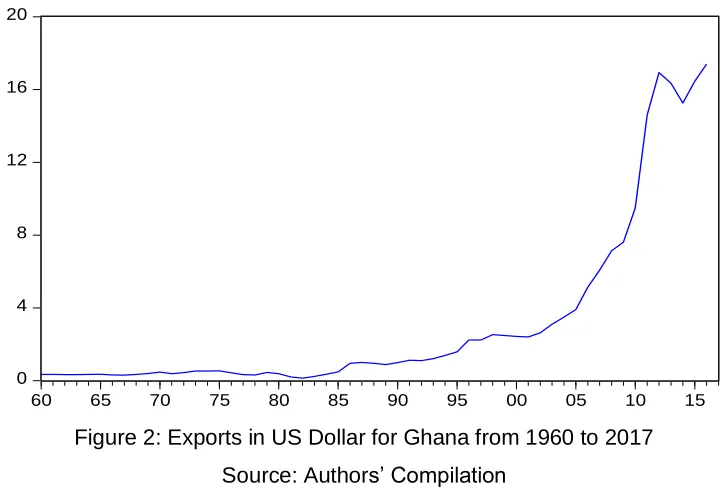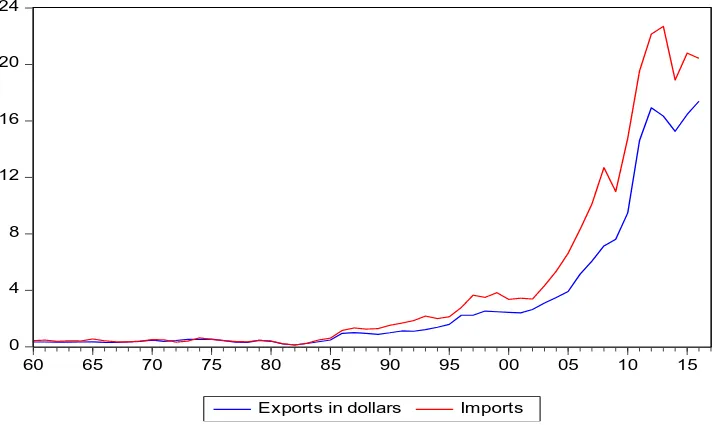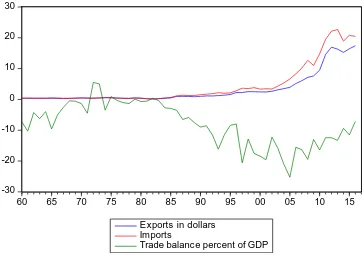Licensed under Creative Common Page 149
http://ijecm.co.uk/
GHANA’S EXPORT AND IMPORT TRADE: AN EMPIRICAL REVIEW
Isaac Ibrahim
School of Economics, Huazhong University of Science and Technology, Wuhan, China safarailioncrimson@yahoo.ca
Liu Haiyun
School of Economics, Huazhong University of Science and Technology, Wuhan, China
Abstract
Globalization has increased interactions among nation-states and international trade has been
deemed as a major driver of globalization, along with international investment and information
technology. Many trade theories posit that gains from trade arise when nations specialize in the
production of goods in which they have comparative advantage and trade for goods in which
they have a comparative disadvantage. This gives rise to the concepts of exports and imports.
This study adopts an empirical approach to review the exports and imports of the economy of
Ghana, with a view to determining the trade balance as well as provide a vivid picture of the
country’s trade, The findings are that the country’s imports exceed exports with negative trade
balance, which is as a result of the low value of exports, in contradistinction to high value
manufactured imports.
Keywords: Ghana, international trade, exports, imports, balance of payments
INTRODUCTION
All things being equal, trade is supposed to be beneficial to economies that engage in free trade. China‟s rise over the past 40 years, since reforming and opening up has been largely attributed to the country‟s emergence as a global superpower.
Licensed under Creative Common Page 150
country can produce all the goods its citizenry needs, trading provides a variety of goods and services that increase the standard of living of the citizenry.
Some economists, however, believe that openness to trade can be harmful, such as import substitution industries for example. However, trade is generally seen to beneficial and it can be more costly not to trade.
At the same time, whilst countries like China and other developed countries seem to benefit from trade with a positive balance, least developed, and some developing economies are suffering from a situation where their imports outweigh exports, leading to a negative balance of payment problems.
Problem Statement
Ghana‟s comparative advantage lies the many resource abundance; chief among them being precious minerals such as gold, diamond, bauxite, and manganese. The country is also a leading exporter of cocoa and timber. The country, however, like most sub-Saharan African economies is saddled with external debts such as IMF loans and depends on much of donor support.
The question that begs for answer therefore is; if the trade is so beneficial, and the country is endowed with such resources, why is it faced with such a scenario. This is the problem that calls for research.
Aims of the Study
The prime of this research is to evaluate the exports and imports composition of Ghana‟s international trade, using empirical data to provide an overview of the country‟s trade situation and serve as a foundation for further research.
LITERATURE REVIEW
This section of research reviews scholarly literature on trade. The review includes arguments for and against trade as submitted by authors in their studies.
Gains from trade
Licensed under Creative Common Page 151
in the economy. According to Esfahani (1991), exports are beneficial in eliminating barriers that may exist in foreign markets.
On the channels of impact, Helpman and Krugman (1985), submit that exports, benefits economic growth, by foreign technological adoption as well as benefits that accrue to large scale economies. In a study by Michaely (1977), he argues that exporting can enhance developing countries‟ development. Authors such as Chenery and Strout (1966) submit further that exports can increase foreign exchange earnings and balance of payment improvements, as well as importation, needed manufacturing technologies
Arguments against Trade
Some authors, are of the view that trade may not be as beneficial. In his studies, for example, Li (2003) reports that importation of services impacts negatively on the growth of developing countries. According to Zafar Ali (2007), oil importation leads to upward sing in prices detrimental to poor economies in Africa. Tull (2006) adds that cheap Chinese textile imports have impacted negatively African local textiles, similar to results by Ibrahim (2017). Hilson et al (2014) attribute illegal gold mining in Ghana to trade. Aryee et al (2003) adds further that soil and water contamination, as well as land degradation, has been the result
Conclusion on the Literature Review
From the literature review, it can be realized that whilst exports are largely seen to benefit the economy, imports, although may be beneficial in terms of providing variety and allowing acquisition of production technology, generally impacts negatively on the economy. Therefore, whether an economy will be better or worse off depends on its composition of trade (exports as against imports in terms of value).
RESEARCH METHODOLOGY
This study adopts an empirical methodology employing the interpretive approach to interpreting time series data from 1960 to 2017, from secondary data sources such as the World Bank country indicators trade data on Ghana, CIA Factbook and Ghana government records on trade.
Nations Competitive Advantage – Porter’s Diamond
Licensed under Creative Common Page 152
Competitiveness at the Harvard Business School. The diamond is a proactive economic theory, as opposed to simply quantifying a country or region‟s comparative advantage.
According to Porter‟s diamond, nations can create new advantages of factor endowments which includes, skilled labor, and strong technology industry as well as government support of a nation‟s economy. This theory is different from traditional theories that focus on a country‟s endowments such as natural resources, labor and population size, land, and locational advantages as the primary determinants of a nation‟s comparative advantage. The porter‟s diamond which is illustrated by the diagram below resembles the shape of a diamond from which it derives its name. The four points of the diamond depict the four interrelated determinants which are theorized by Porter, as the deciding factors of a nation‟s comparative advantage. The factors are the strategy of the firm, structure and rivalry, the related supporting industries, conditions of demand as well as factor conditions. The strategy of the firm, structure, and rivalry posits that competition promotes efficiency in production and technological innovations, whereas related supporting industries stands for downstream and upward industries which facilitate innovation through the exchange of ideas. Conditions of demand stand for the nature and size of the customer base for a product, which also promotes innovation and improvement of products. The most important, according to Porter's, is factor conditions. Factor conditions represent elements that he believes an economy can create for itself, including, the large pool of skilled labor, infrastructure, capital, and technological innovation. He argues that factor conditions are an important determinant of a nation‟s comparative advantage as compared to natural factor endowments. He argues further, that government‟s role is needed in the driving of the economy; challenging business creation of factor conditions, by stimulation competition through anti-trust law enforcement.
Licensed under Creative Common Page 153
ANALYSIS AND FINDINGS
This section reviews the trade structure of Ghana, in terms of exports and imports, examining empirical data and figures in order to determine the over-all trade standing of the country.
Overview of Ghana exports
Ghana‟s exports composition is as gold (4.43bn USD), cocoa (1.89bn USD), cashews, nuts (987m USD), crude oil (960m USD), and timber (367m USD). Exports in Ghana reached an all-time high in the first quartile of 2012 recording 4118.830m USD, with the lowest point being recorded in 2003 1st quartile (565.06m USD). Basically, Ghanaian exports, as can be seen from the composition of the basket are primarily agricultural goods, raw materials, and low-value items which do not generate much foreign exchange earnings. The top export destinations as at 2016 were Switzerland (1.87bn USD), India (1.56bn USD), United Arab Emirates (1.43bn USD), China (941m USD), and Vietnam (549m USD). Ghana‟s trade volume is shown in the figure below.
0 4 8 12 16 20
60 65 70 75 80 85 90 95 00 05 10 15
Exports in dollars
Figure 2: Exports in US Dollar for Ghana from 1960 to 2017 Source: Authors‟ Compilation
Overview Ghana imports
Licensed under Creative Common Page 154
0 4 8 12 16 20 24
60 65 70 75 80 85 90 95 00 05 10 15
Imports
Figure 3: Imports in US Dollar for Ghana from 1960 to 2017 Source: Authors‟ Compilation
Ghana’s balance of payment deficit
From the analysis above, the composition, and volume of exports and imports are notable. Generally, exports have increased on average, largely attributable to gold and cocoa exports. However, Imports have increased faster, outweighing exports. In 2016 for example, whereas Ghana imports stood at 11billion (bn) USD, its exports stood at 10.5bn USD with a deficit of 508million (m) USD. The figure above depicts the trade situation in Ghana.
0 4 8 12 16 20 24
60 65 70 75 80 85 90 95 00 05 10 15
Exports in dollars Imports
Licensed under Creative Common Page 155
From the graph above the red line denoting imports rises above the blue line which denotes exports, leading a deficit trade balance as shown below.
Figure 5: Exports, imports and trade balance for Ghana from 1960 to 2017 Source: Authors‟ Compilation
This implies that Ghana spends more to the world in trade than it earns from trading with the world economies.
CONCLUSIONS
Openness to trade is beneficial and gains from trade can accrue to countries engaging in it. Trading economies enjoy a variety of goods the world economy provides and trade has the advantage of resulting in promoting specialization, domestic competition, and efficiency. Further, trade can result in economic growth and development as well as investment.
However, the net gains from trade can either be positive or negative in terms of the balance of payments, comparing exports and imports volume and composition. Ghana like many developing economies earn less from trade than it spends to trade due to the low value and volume of its exports and compared to higher value and volume of imports.
It is incumbent on the government of Ghana and other developing countries to find ways to reverse the situation where exports exceed imports if it is to promote its development agenda.
-30 -20 -10 0 10 20 30
60 65 70 75 80 85 90 95 00 05 10 15
Exports in dollars Imports
Licensed under Creative Common Page 156
RECOMMENDATIONS
The country should take steps to avert the deficit situation. Attempts should be channeled towards increasing export volume and reducing the volume of imports. First, the government needs to drive the economy towards changing factor conditions and cause a shift towards manufacturing and value addition to exports. Further, the country should take other measures such as attracting foreign direct investment into the country, to boost production, manufacturing, and industry. This will not only boost exports but also reduce the import bill.
FURTHER STUDIES
This study has reviewed the export and import trade of Ghana and has found the country is facing a negative balance of payment in trade. Based on the recommendations of this study, future research should focus on providing detailed solutions to the problems, as to how foreign direct investment can help promote trade of the country.
ACKNOWLEDGMENT
Many thanks to my dissertation, supervisor Liu Haiyun of the School of Economics, Huazhong University of Science and Technology for his guidance and supervision.
REFERENCES
Aryee, B. N., Ntibery, B. K., & Atorkui, E. (2003). Trends in the small-scale mining of precious minerals in Ghana: a perspective on its environmental impact. Journal of Cleaner production, 11(2), 131e140.
Chenery, H., B., Strout, A. M. (1966,). “Foreign Assistance and Economic Development”, The American Economic Review, Volume LVI, Number 4, Part I.
E. Helpman and P. Krugman (1985). Market Structure and Foreign Trade: Increasing Returns, Imperfect Competition and the International Economy. MIT Press, Cambridge,
Edwards, S., (1992). Trade orientation, distortions and growth in developing countries. Journal of Development Economics 39, 31 – 57
Eggert, R. G. (2001). “Mining and economic sustainability: National economies and local Communities”. Background study prepared for the Mining, Minerals, and
Esfahani, H. (1991). Exports, imports and economic growth in semi-industrialized Countries. Journal of Development Economies 5: 93-116
Hilson G., Hilson A., & Adu-Darko, E. (2014), „Chinese participation in Ghana informal gold mining economy: drivers, implications and clarifications‟, in Journal of Rural Studies, vol.34, pp.292-303.
Ibrahim. I. (2017). Impact of Sino-African Economic Relations on the Ghanaian Economy: The Case of Textiles. International Journal of Innovation and Economic Development, 3(1), 7-27.
Li, X., Greenway D., Hine, R. (2003). Imports of Services and Economic Growth: A Dynamic Panel Approach
Michaely, M. (1977). “Exports and Growth: An Empirical Investigation” Journal of Development Economics, Vol. 4: 49-53
Sukar, A, and Ramakrishna.G (2002). “The Effect of Trade Liberalization on Economic Growth: The Case of Ethiopia”, Finance India, Vol. 26, No.4, p.1295-1305.
Licensed under Creative Common Page 157
Wacziarg, Romain and Karen Horn Welch, (2003). “Trade Liberalization and Growth: New Evidence.” NEBR Working Paper No. 9305, p. 1-70



